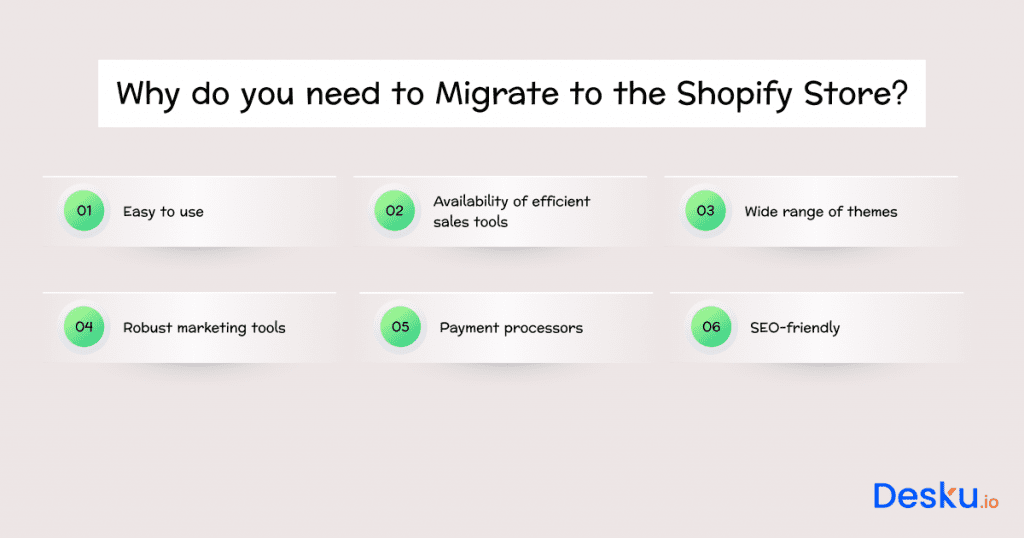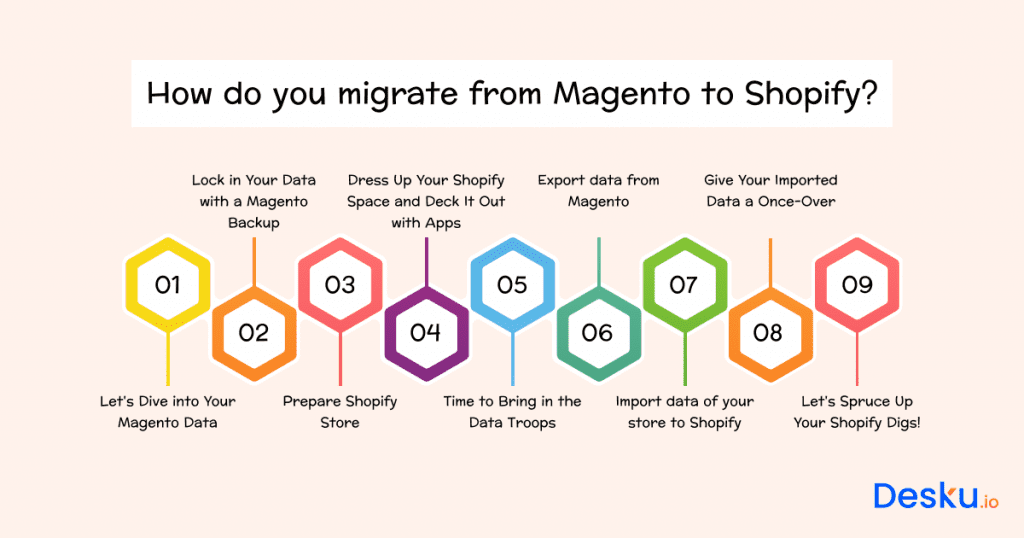Who doesn’t know Magento? It’s a popular open-source platform that helps you create stunning e-commerce websites. It acts very similar to WooCommerce. It has been leading as one of the best e-commerce solutions for years.
However, in the e-commerce field, it is not guaranteed how long we will use any platform. As technology evolves at an unbelievable speed, new e-commerce solutions are introduced. New tools and features accompany all the newbies.
Shopify is also an e-commerce solution that has become a top player in the e-commerce market in recent years. Besides creating e-commerce websites, it also provides web-hosting functionality. That’s the reason many people have started migrating from Magento to Shopify.
Today, we will share a guide on how you can easily switch from Magento to Shopify without creating blunders.
A Quick Word: How does Desku complement your Magento to Shopify Migration?
As you migrate your online store from Magento to Shopify, the transition can bring about changes in customer behavior and support requirements. Desku acts as a reliable ally during this transition. It ensures a smooth and uninterrupted customer support experience.
If there are changes in your product catalog and you want to handle inquiries related to the migration process, Desku’s features can be a great time savior. For example, it has a Ticketing system, which effortlessly teams up with coworkers and promptly resolves intricate issues.
Desku’s features are tailored to meet the evolving needs of your support team. You can make the most out of Desku as you migrate to Shopify and elevate your customer support to new heights. Also, you can try Desku for free for the first 14 days by signing up for a free trial!
Key Takeaway :
This article provides a step-by-step guide on how to migrate from Magento to Shopify without making any mistakes. It also highlights the benefits of using Shopify over Magento, such as its user-friendly interface, efficient sales tools, wide range of themes, robust marketing tools, and SEO-friendly features.
Why do you need to Migrate to the Shopify Store?

There are numerous reasons why so much emphasis is being laid on migration to Shopify. The first and foremost reason is that Shopify is huge. A recent report says it has 3 million+ online stores designed. Besides this, it has plenty more reasons to attract people to it. We will give you a glance at all of them here:
1). Easy to use
Shopify never demands technical knowledge for its usage. So, you can think how user-friendly its environment is. It showcases the drag-and-drop functionality through which you can easily create your website on the go.
2). Availability of efficient sales tools
In the e-commerce field, there is no meaning in having a website that does not contain any sales tools. As e-commerce revolves completely around selling, Shopify provides a huge list of sales features that would help you in different product selling processes like multi-channel, digital, physical, video banners, popups, forms, and so on. Some, who need higher level sales tools prefer going with Shopify Plus.
3). Wide range of themes
When you want to create online stores, you would need some tempting layouts to grab your customer’s attention. That’s why Shopify gives you an enormous theme collection from which you can easily select your perfect one. Moreover, you can customize these layouts per your needs without any coding knowledge. Just for example, you can boost your sales just by putting interesting videos in your footer!
4). Robust marketing tools
Shopify is not only an e-commerce website creation platform. In fact, it helps you promote your website through its amazing marketing tools. You can even analyze the marketing campaign results to bring improvement through these tools. However, if you struggle in making sales funnels, read this comparison blog that will certainly help you out.
5). Payment processors
In the e-commerce platform, payments are made digitally. Through Shopify’s payment processor called Shopify Payment, you can allow seamless and free payment processes. Besides this, it also contains 100+ payment gateways that are paid.
Also read: Do You Need a Business License to Sell on Shopify?
6). SEO-friendly
Shopify provides you with SEO tools that allow you to monitor your website’s performance on search engines. On the basis of the reports, you get to know what actions you need to take to get better.
Magento to Shopify Migration Checklist: What data can I need to migrate?

One question will surely strike your mind during the migration: which data would you migrate?
So, here is the answer:
- Visuals of products- Product details like color, shape, and size.
- Product categories- All the information related to your products, like descriptions, prices, URLs, images, and much more.
- Integrations include your customer details like name, address, phone number, and more.
- Images- Various images on your website related to products and content.
- Static page content– All the content belonging to your website’s static pages, like About Us, Contact Us, blogs, and more.
Once you’ve considered this checklist, you can get to the Shopify app store, get your preferred Shopify theme, and head towards the migration process. You can even hire a migration service if you’re not that technically sound. If you’re confident about completing the Magento to Shopify data migration, then let’s move ahead with the process.
How do you migrate from Magento to Shopify?
Step 1 – Let’s Dive into Your Magento Data
Once we migrate to the new Shopify store, we will lose all our access to data stored in Magento. So, it becomes important for us to collect all the data stored in Magento, as it will be crucial. That’s why, before starting the migration, all we need to do is to find all stored data like customer data, passwords, and product information through a data audit.
Step 2 – Lock in Your Data with a Magento Backup
Whenever we format our phones, we would back up our important data. The same thing applies to this migration. Before starting it, we will need to backup the data in Magento:
- Firstly, you need to visit Magento’s admin panel, where you will be required to click on the ‘System’ button.
- Under the system section, you need to click on the ‘Tools’ section.
- You will find the’ Backup’ option in the upper-right corner of the tools section.
Magento allows you to undergo three types of backups:
- Database and Media Backup: Here, you can back up your database and media data altogether.
- Database Backup: This allows you to backup only your database.
- System Backup: Through system backup, you can get the backup of all the data stored in your Magento account before data migration.
Step 3- Prepare Shopify Store
After backing up our data from Magento, we will now move forward with creating our Shopify account. When you first create your Shopify account, it will give you a 14-day free trial. Through this trial, you will get to know all the features and functionalities of Shopify.
After these 14 days, you will be charged based on your selected plan:
- Basic Shopify ($29/month)
- Shopify ($79/month)
- Advanced ($299/month)
Step 4 – Dress Up Your Shopify Space and Deck It Out with Apps
Once you have created your Shopify account, it’s time to build your e-commerce website. You might think it to be a tough task, but with Shopify, it becomes much easier. All you need to do is to select a theme from Shopify’s theme collection. It’s not at all compulsory for you to stick with the theme permanently. You can change it later.
After the theme selection task, Shopify will present you a list of options, like a search button, product reviews, etc., that you embed in your online store. Here, you need not worry if you are a non-technical person, as you will simply have to drag and drop the options. That’s it.
Step 5 – Time to Bring in the Data Troops
Now, it’s time to import all the useful data that you would need in your online store. And this task is not going to be tough at all. Shopify already has a strong application for it called ‘Store Importer’. For this, you will need to visit the admin panel, click the Apps button, and select the Store Importer option. Within a few minutes, all your data will be imported.
Step 6- Export data from Magento
After the successful data transfer, you are good to go with Shopify. Before that, you will have to perform the final task of exporting data from Magento.
- You will have to log in to Magento’s admin panel and head to System>Data Transfer>Export.
- In the export section, you will find three entity options: products, customer addresses, and customers’ main files.
Though it might not happen every time, you might need to repeat the import process:
- You must keep the default file format to XML/CSV.
- If your data contains any special characters, you can check the enclosure box.
- Now, you need to select the continue button.
- By default, Magento stores all the exported data in < Magento-root-directory>/var/export folder. And, in case you choose a remote storage module, then the storing path will be:< remote-storage-root-directory>/import_export/export folder.
Step 7- Import data of your store to Shopify
Once all of your Magento data is exported, you can import it in Shopify:
- First, log in to Shopify’s admin page and navigate through Apps>Import Store.
- Magento will not be listed in the platform section. So, you will have to select the “Other” option.
- Then, you will have to select your exported files by clicking on the Upload files.’
- You will have to select the CSV files in the exported files.
- Finally, you have to click on the ‘Continue Import’ button.
If there is a scenario where you need to import all the exported files separately, then:
For Product files:
- Visit the Shopify admin panel.
- Go to the product section and select ‘All Products.’
- Click on the ‘import’ button.
- Then, under the ‘Add file’ section, choose ‘Add product CSV file’.
- Finally, click on the ‘upload file’ button.
For customer files:
- Visit the Shopify admin panel.
- From the ‘Customers’ section, select ‘Import Customers.’
- Under the ‘Add file’ section, select the customer CSV files.
- Finally, click on the ‘Import Customers’ button.
There is one noteworthy point: You won’t be able to export customers’ passwords to Shopify. As they are stored in encrypted form in Magento, they would not be exported.
Moreover, you will always need to follow the following sequence to import data in Shopify:
- Products
- Customers
- Historical orders
Step 8 – Give Your Imported Data a Once-Over
Now, despite following the steps carefully, there are high chances of failure at some points:
- Failed Import Drama: Although you carefully executed the migration process, the products and customer data might not get imported. But there is no need to panic. You can add them manually instead.
- Unpublished but Successful: Even though you get a “Successfully Imported” message, there is a chance that some of your data might not have been imported. This happens as some data might have ‘hidden’ visibility. In such a scenario, you check into the product availability section.
- Variant Vanishing Act: There is a high chance that your product variants might not get imported successfully. However, you can import them manually.
- Dimension Dilemma: Sometimes, the product dimensions would not be delivered. In such cases, you must manually input the dimensions in the product descriptions.
- Bundle Brouhaha: There might be a case where bundled products would not get imported. Now, there can be two solutions for this issue. You can either add them manually or through product bundling apps by Shopify. The choice will be yours.
Step 9 – Let’s Spruce Up Your Shopify Digs!
A big congratulations to you as we have reached the final stage of migration. Now, it’s time to finalize the theme for your online store.
For this reason, Shopify deserves a patting as it provides a huge collection of themes to its users. With 70+ themes, of which 60+ are paid and 10 are free, Shopify has become a star of e-commerce design. In the case of Magento, you would not find such attractive themes. That’s a great reason why e-commerce businesses prefer Shopify over Magento for website building.
Moreover, all these design templates are mobile-friendly. So, your customers will always have a good experience on all platforms.
Is there a Magento to Shopify migration app?
Although you would not find any migration feature in Shopify, you can get third-party applications in its app store. These third-party applications, like litExtension and Cart2Cart, will allow you to migrate from Magento to Shopify easily. They will charge some amount, but you can achieve successful migration through these apps.
How much does it cost to migrate from Magento to Shopify?
Well, the migration cost is never going to be fixed. It depends on the size of your inventory, order list, and customer list. The bigger the size of these things, the bigger the amount you will have to pay. Besides this, the pricing factor depends on which entities you will remove and which you will keep.
When pricing is the deciding factor, good research can really help you out. Before opting for any application, you should compare them in terms of their ratings and pricing. So it becomes much easier for you to decide on the perfect and affordable option.
Conclusion
So, we are confident that you have got the perfect idea about migrating from Magento to Shopify. Magento is not outdated. It’s just that Shopify has some astounding features that any e-commerce solution would require today.
We have uncovered the steps you should take for migration. Besides this, here we have also shared some challenges that many of you might face. However, with our solutions in your hand, you will be able to overcome them with ease.
See, it’s not as simple as picking up your data from your Magento store and going to the Shopify store to drop it all. There are a few intricacies there. If you aren’t confident, you can even consider hiring Magento to Shopify migration service.




